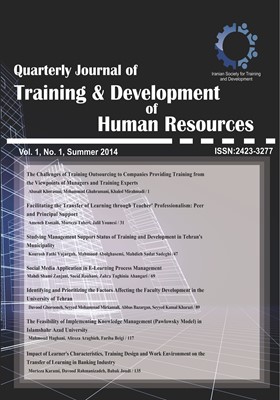-
-
List of Articles
-
Open Access Article
1 - The Challenges of Training Outsourcing to Companies Providing Training from the Viewpoints of Managers and Training Experts
خالد میر احمدی -
Open Access Article
2 - Facilitating the Transfer of Learning through Teacher’ Professionalism: Peer and Principal Support
morteza taheri -
Open Access Article
3 - Studying Management Support Status of Training and Development in Tehran’s Municipality
mahmood abolghasemi -
Open Access Article
4 - Social Media Application in E-Learning Process Management
مهدی شامی زنجانی زهرا تقینیا آهنگری -
Open Access Article
5 - Identifying and Prioritizing the Factors Affecting the Faculty Development in the University of Tehran
داود قرونه Seyyed Mohammadi Mirkamali عباس بازرگان سیدکمال خرازی -
Open Access Article
6 - The Feasibility of Implementing Knowledge Management (Pawlowsky Model) in Islamshahr Azad University
-
Open Access Article
7 - The Feasibility of Implementing Knowledge Management (Pawlowsky Model) in Islamshahr Azad University
Mahmoud Haqqani فریبا بیگی -
Open Access Article
8 - Impact of Learner’s Characteristics, Training Design and Work Environment on the Transfer of Learning in Banking Industry
-
The rights to this website are owned by the Raimag Press Management System.
Copyright © 2017-2026







